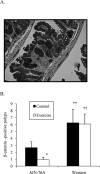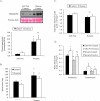The interaction of a high-fat diet and regular moderate intensity exercise on intestinal polyp development in Apc Min/+ mice
- PMID: 19549797
- PMCID: PMC2886505
- DOI: 10.1158/1940-6207.CAPR-09-0017
The interaction of a high-fat diet and regular moderate intensity exercise on intestinal polyp development in Apc Min/+ mice
Abstract
Diet and exercise are two environmental factors that can alter colon cancer risk. The purpose of this study was to determine if regular moderate-intensity treadmill exercise training could attenuate polyp formation in Apc(Min/+) mice fed the Western-style diet. Four-week-old male Apc(Min/+) mice (n = 12 per group) were assigned to AIN-76A Control, AIN-76A Exercise, Western Control, or Western Exercise treatment groups. Mice were weaned to these diets and either subjected to regular moderate-intensity treadmill exercise (18 m/min, 60 min/d, 6 d/wk) or remained sedentary for 6 weeks. Mice fed the Western-style diet consumed approximately 14% more calories and had 42% more epididymal fat compared with mice fed the AIN-76A diet. Exercise had no effect on fat pad mass with either diet treatment. Exercise reduced total intestinal polyp number by 50% and the number of large polyps (>1 mm diameter) by 67% in AIN-76A-fed mice. The Western-style diet increased polyp number by 75% when compared with AIN-76A-fed mice, but exercise did not decrease polyp number or alter polyp size in mice fed the Western-style diet. Markers of systemic inflammation and immune system function were improved with exercise in mice fed the AIN-76A diet. Mice fed the Western-style diet showed more inflammation and immunosuppression, which were not completely ameliorated by exercise. These data suggest that the induction of adiposity, inflammation, and immunosuppression by the Western-style diet may compromise the beneficial effect of moderate-intensity exercise on the intestinal polyp burden in Apc(Min/+) mice.
Figures




References
-
- Cancer Facts and Figures 2008. American Cancer Society; Atlanta: 2008.
-
- Potter JD. Colorectal cancer: molecules and populations. J Natl Cancer Inst. 1999;91:916–32. - PubMed
-
- Quadrilatero J, Hoffman-Goetz L. Physical activity and colon cancer. A systematic review of potential mechanisms. J Sports Med Phys Fitness. 2003;43:121–38. - PubMed
-
- Giovannucci E. Metabolic syndrome, hyperinsulinemia, and colon cancer: a review. Am J Clin Nutr. 2007;86:s836–42. - PubMed
-
- Moghaddam AA, Woodward M, Huxley R. Obesity and risk of colorectal cancer: a meta-analysis of 31 studies with 70,000 events. Cancer Epidemiol Biomarkers Prev. 2007;16:2533–47. - PubMed
Publication types
MeSH terms
Grants and funding
LinkOut - more resources
Full Text Sources

